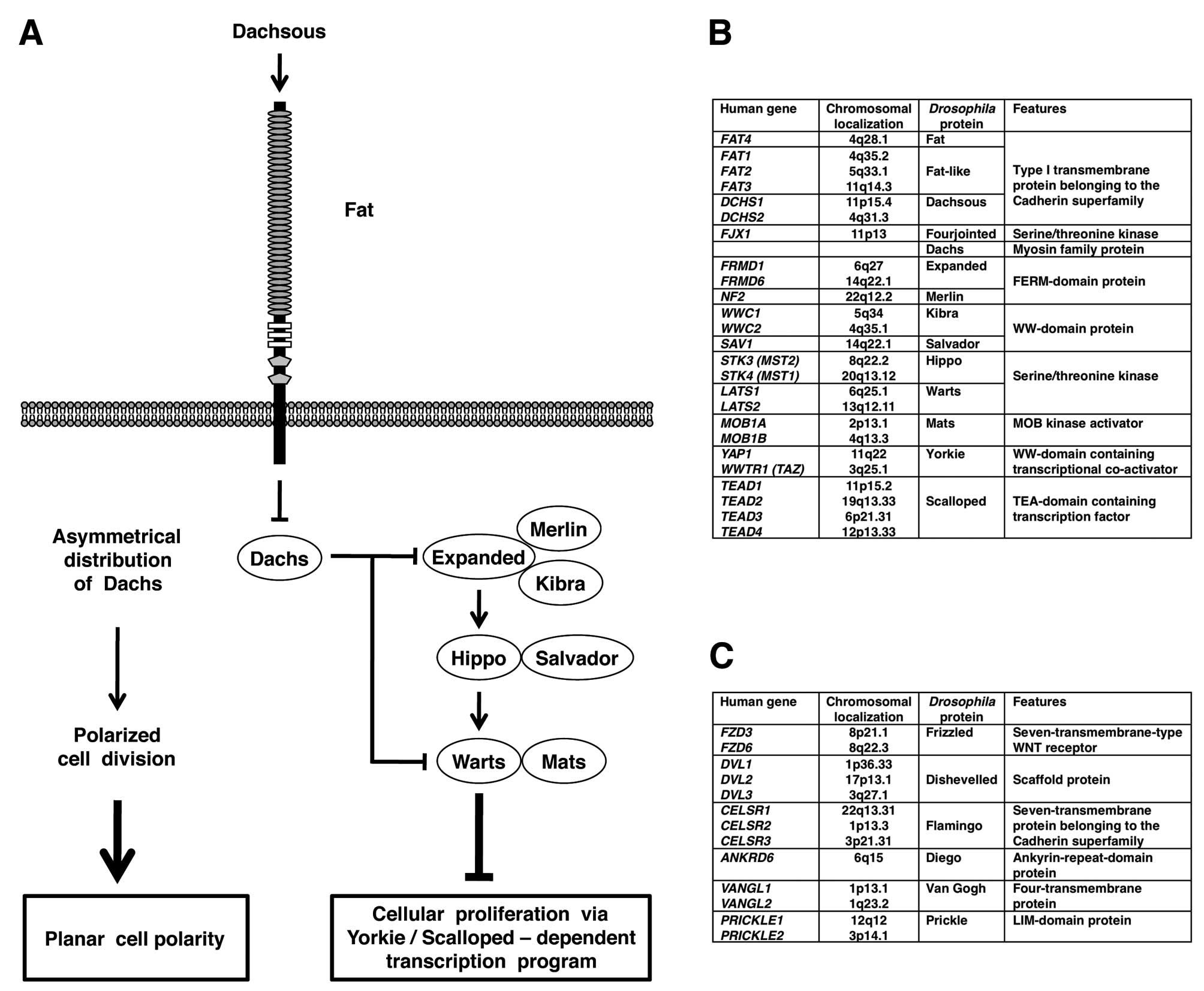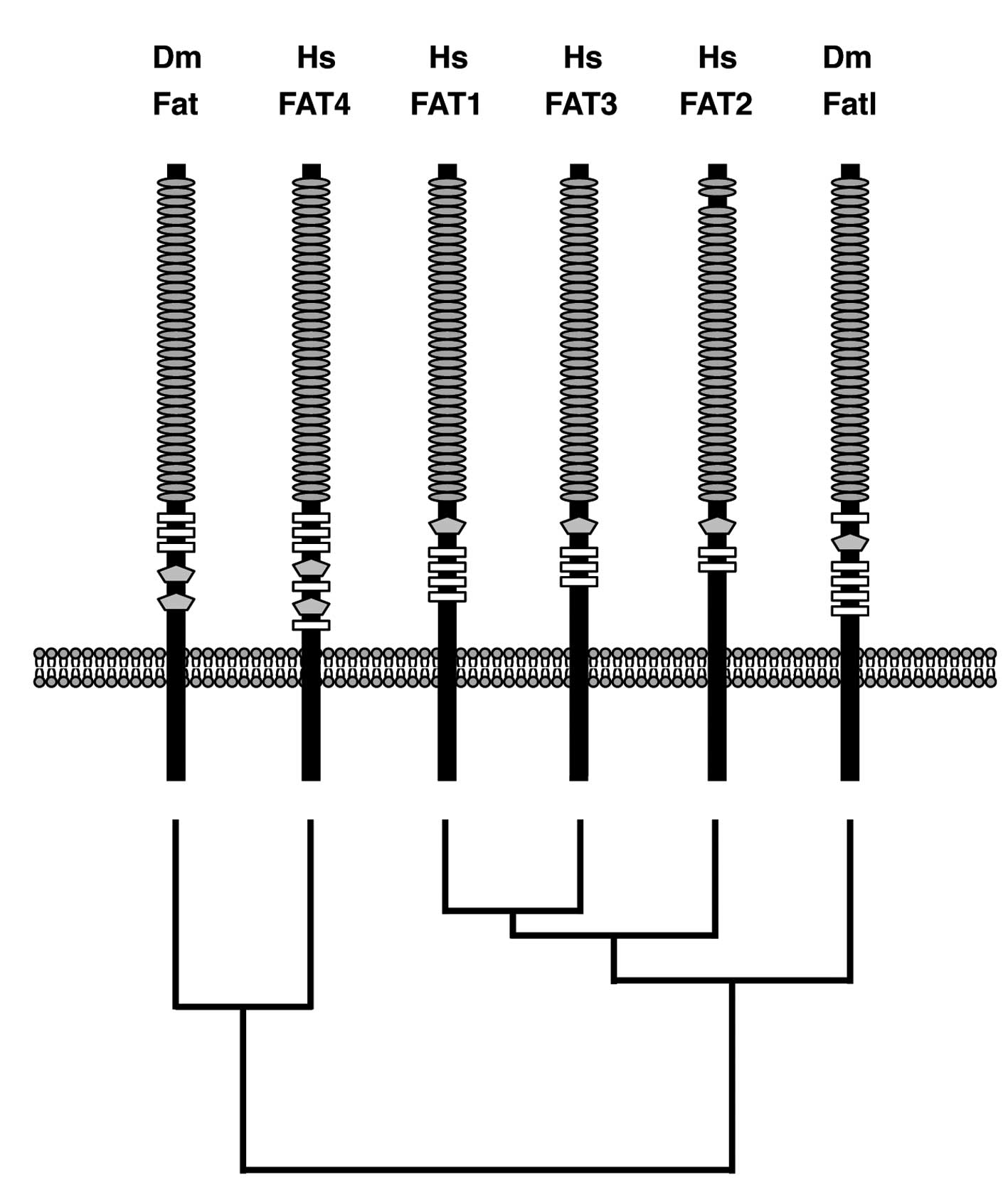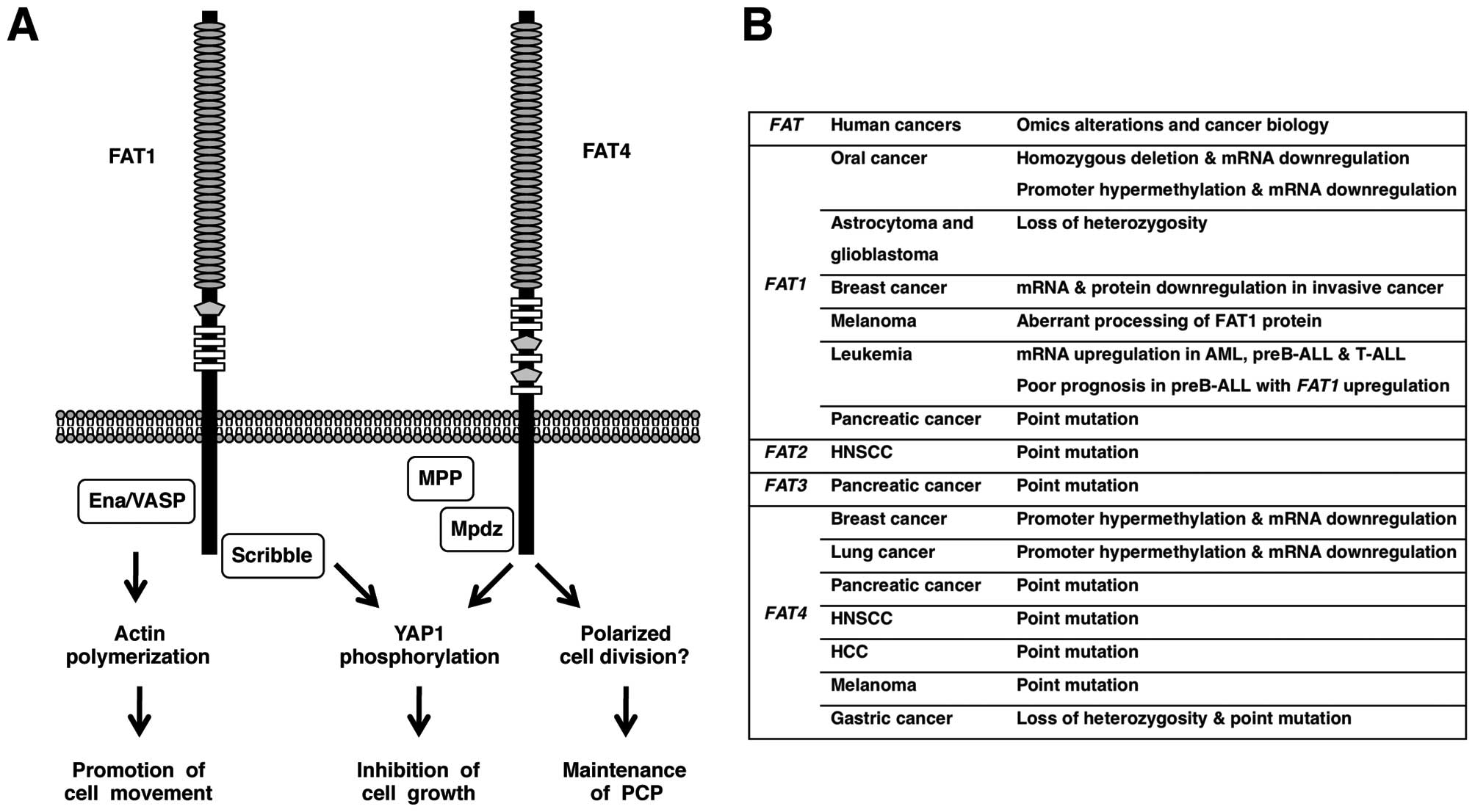Function and cancer genomics of FAT family genes (Review)
- Authors:
- Published online on: October 17, 2012 https://doi.org/10.3892/ijo.2012.1669
- Pages: 1913-1918
-
Copyright: © Katoh . This is an open access article distributed under the terms of Creative Commons Attribution License [CC BY_NC 3.0].
Abstract
Contents
Introduction
FAT family
Processing of FAT proteins
Signaling and function of FAT1 and FAT4
Cancer genomics of FAT family genes
Conclusion
Perspectives
Introduction
Drosophila mutants of the fat, discs large (dlg), lethal giant larvae (lgl), warts, scribble, salvador and hippo genes show tissue overgrowth (1–7). Overgrowth mutants of fat, warts, salvador and hippo are characterized by hyperplastic tumors mostly retaining single-layered epithelial structure, whereas those of scribble, dlg and lgl are characterized by neoplastic tumors losing epithelial structure (8,9). Drosophila fat gene is genetically upstream of the warts, salvador and hippo genes, which are involved in the repression of Yokie-Scalloped-dependent transcription of cyclin E and diap1 genes (10–13). Because cyclin E and diap1 genes encode cell cycle accelerator and apoptosis inhibitor, respectively, loss-of-function mutations of Drosophila fat gene give rise to hyperplastic tumors through increased cell proliferation and decreased cell death (Fig. 1A).
In addition to tumor suppression, Drosophila fat gene is involved in planar call polarity (PCP) (Fig. 1A). PCP is the cell polarity within the plane of epithelial tissues orthogonal to the apical-basal axis (14–17). PCP is established as a result of the asymmetrical localization of the Flamingo-Frizzled-Dishevelled-Diego complex and the Flamingo-Strabismus-Prickle complex of adjacent cells via homophilic interaction of extracellular cadherin-repeat region of Flamingo. Drosophila frizzled, dishevelled, diego, flamingo (starry night), strabismus (van Gogh) and prickle genes encode the core PCP components (18–20), while Drosophila fat, dachsous, four jointed, discs overgrown and dachs genes encode the additional or complementary PCP components (21–24).
Drosophila fat gene encodes a large transmembrane protein with 34 Cadherin repeats, 4 EGF-like domains and 2 Laminin G-like domains in the extracellular region (25). Fat protein belongs to the Cadherin superfamily, which is classified into the classical cadherin family, Flamingo/Celsr family, Fat/Dachsous family and others (26,27). Extracellular regions of Fat and Dachsous cadherins on adjacent cells are reported to preferentially interact in a heterophilic manner (14,15). Four jointed and Discs overgrown are serine/threonine kinases that phosphorylate extracellular domain of Fat in the Golgi and intracellular domain of Fat in the cytoplasm, respectively, to promote Fat signaling (21–24). Heterophilic interaction of Fat and Dachsous cadherins leads to asymmetrical localization of Dachs myosin; depletion of Dachs in the Fat side and accumulation of Dachs in the Dachsous side. Asymmetrical Dachs localization induces PCP through tension anisotrophy-oriented cell rearrangement as well as tumor suppression though Hippo-Salvador-Warts signaling-mediated Yorkie repression (Fig. 1A).
Drosophila components of Fat-Hippo and Fat-PCP signaling cascades are well conserved in mammals, especially in human (Fig. 1B and C). Although precise mechanisms of the Fat-Hippo and Fat-PCP signaling cascades are not completely elucidated, growing pieces of evidence indicate the involvement of the mammalian FAT signaling cascades in embryogenesis and carcinogenesis. In this report, function and cancer genomics of the human FAT family members are reviewed.
FAT family
The human FAT gene family consists of the FAT1, FAT2, FAT3 and FAT4 genes (28–31). Dunne et al reported complete coding sequence of FAT1 in 1995. Wu and Maniatis reported complete coding sequence of FAT2 in 2000. Höng et al reported partial coding sequence of FAT3 in 2004. We reported complete coding sequence of FAT3 and FAT4 in 2006. The FAT1 and FAT3 genes adjoin the MTNR1A and MTNR1B genes, respectively. FAT1 is most homologous to FAT3, while MTNR1A is most homologous to MTNR1B. These facts clearly indicate that the FAT1-MTNR1A locus on human chromosome 4q35.2 and the FAT3-MTNR1B locus on human chromosome 11q14.3 are paralogous regions within the human genome (31).
Human FAT family genes as well as Drosophila Fat family genes encode large proteins with extracellular Cadherin repeats, EGF-like domains, and Laminin G-like domain(s). Codon 275–352 of FAT2 is homologous to the third Cadherin repeat of FAT1; however, this region of FAT2 was not predicted as the Cadherin repeat using the conserved domain search (CDS) program of NCBI. Codon 3790–3828 of FAT1 and codon 3799–3834 of FAT3 are distantly related to the EGF-like domain; however, these regions were not predicted as the EGF-like domain using the CDS program. Because Cadherin repeat and EGF-like domain are defined in a low-stringent manner, it is ambiguous at present whether regions distantly related to Cadherin repeat and EGF-like domain are functional or not. Domain architectures of human FAT1, FAT2 FAT3, FAT4 and Drosophila Fat and Fat-like (Fatl) were illustrated based on the results of the CDS program using each RefSeq as a query sequence. Domain-architecture topologies of the region between Cadherin repeats and the transmembrane domain of human FAT1, FAT2, FAT3 and Drosophila Fatl are a Laminin-G-like domain followed by multiple EGF-like domains, whereas those of human FAT4 and Drosophila Fat are multiple EGF-like domains followed by two Laminin-G-like domains (Fig. 2). Phylogenetic analyses on human and Drosophila FAT family proteins revealed that only FAT4 is located within the same branch as Drosophila Fat (Fig. 2). Together, these facts indicate that human FAT1, FAT2 and FAT3 are orthologs of Drosophila Fatl, and that human FAT4 is the ortholog of Drosophila Fat.
Processing of FAT proteins
FAT1 and FAT4 undergo the first proteolytic cleavage in the extracellular region by Furin during their maturation step, which gives rise to non-covalent heteodimer consisting of a larger subunit corresponding to the most part of the extracellular region and a smaller subunit containing the transmembrane and cytoplasmic regions (22,32). Artificial FAT proteins undergo the second proteolytic cleavage by γ-secretase and the release of intracellular region, which is similar to the ligand-dependent processing of NOTCH receptors (33). However, evidence of the ligand-dependent second cleavage of endogenous FAT proteins remains unclear.
Signaling and function of FAT1 and FAT4
Dachsous1 (DCHS1) and Dachsous2 (DCHS2) are mammalian orthologs of Drosophila Dachsous (Fig. 1B); however, heterophilic interaction between extracellular regions of FAT1 and Dachsous1/2 remains unknown. On the other hand, intracellular region of FAT1 directly interacts with Ena/VASP, HOMER, KIF5C and Scribble proteins (34–37). Ena/VASP and HOMER are EVH1-domain proteins binding to the cytoplasmic FPPPPEDF motif of Fat1 in a mutually competitive manner. Because Ena/VASP proteins inhibit actin capping and induce actin polymerization, Fat1-mediated recruitment of Ena/VAPS proteins to the leading edge of lamellipodia and the tip of filopodia results in the promotion of cell migration (34,35). Scribble proteins are scaffold proteins with multiple PDZ domains binding to the C-terminal HTEV motif of Fat1. Fat1 and Scribble are synergistically involved in the suppression of cystogenesis phenotype through the inhibition of Yap1 signaling (37). Fat1 knockdown in vascular smooth muscle cells results in decreased migration and enhanced proliferation (38). FAT1 is involved in promotion of actin-mediated cell migration as well as inhibition of YAP1-mediated cell proliferation (Fig. 3A).
Fat4 heterophilically interacts with Dachsous1 at the apical portion of cell-cell boundaries of neural progenitor cells, where intracellular region of Fat4 directly interacts with Mpdz/Mupp1-Mpp5/Pals1 complex (39). Mpp1, Mpp2, Mpp3, Mpp4, Mpp5, Mpp6/Pals2 and Mpp7 are membrane-associated guanylate kinase (MAGUK) homologs of Drosophila Stardust (Sdt), which is involved in the maintenance of apicobasal polarity in epithelial tissues (40). Fat4 knockout mice die at birth, which are manifested by stereocilia disorientation in the inner ear, loop tail, broader neural tube and renal cysts (41). Disorientation of cochlear hair cells is the typical phenotype of the mammalian PCP defect in Vangl2, Celsr1 or Dvl1/Dvl2 mutant mice (42). Loop tail and neural tube abnormalities are also observed in Vangl2 mutant mice (43) and renal cystogenesis is synergistically enhanced in Fat4−/−Vangl2−/+ mice (42). Fat4 knockdown in neural tube results in an increase of a subset of neural progenitors and differentiated Lim1+/Lim2+ neurons via downregulation of Yap1 phosphorylation (44). FAT4 is involved in the maintenance of PCP as well as inhibition of YAP1-mediated cell proliferation (Fig. 3A).
Cancer genomics of FAT family genes
The human FAT1 gene is homozygously deleted in 23% of oral cancer cell lines and in 80% of primary oral cancer cases and FAT1 mRNA expression is repressed in oral cancer cell lines due to homozygous deletion and/or promoter CpG hypermethylation (45). Loss of heterozygosity (LOH) of the FAT1 gene occurs in 42% of low grade diffuse astrocytoma and 63% of glioblastoma multiforme (46). FAT1 mRNA level in ductal carcinoma in situ is significantly higher than that in invasive breast cancer and FAT1 knockdown promotes progression from ductal carcinoma in situ to invasive breast cancer (47). FAT1 mRNA expression is upregulated in 11% of acute myeloid leukemia (AML), 29% of preB acute lymphoblastic leukemia (ALL) and 63% of T-ALL, and FAT1 upregulation in preB-ALL is associated with shorter relapse-free survival as well as shorter overall survival (48). FAT1 immunoreactivity is strong in 29% of cholangiocarcinoma (49).
The mouse Fat3 mRNA is significantly downregulated in lung adenocarcinoma occurred in transgenic mice expressing wild-type Raf1 transgene under the control of the human SP-C (surfactant protein C) promoter (50).
The mouse Fat4 gene is inactivated owing to LOH and promoter CpG hypermethylation in subcutaneous tumor induced by Cre/LoxP-mediated random chromosomal deletion (51). Tumor growth is inhibited by re-introduction of Fat4 gene into cells derived from the cutaneous tumor. Relative YAP1 activity is significantly upregulated as a result of Fat4 repression.
The human FAT4 mRNA expression is repressed in 3 out of 6 breast cancer cell lines and in 3 out of 5 cases of primary breast cancers, partially due to promoter CpG hypermethylation (51). FAT4 promoter is hypermethylated in 7 out of 18 cases of lung adenocarcinoma (stage I) and FAT4 mRNA is downregulated in 18 out of 23 cases of non-small cell lung tumors (stage I or II) (52).
Using the whole-exome sequencing approach, non-synonymous mutations of human FAT1, FAT3 and FAT4 genes are detected in 1 each, and 2 out of 24 pancreatic cancer samples, respectively (53). Non-synonymous mutations of human FAT2 and FAT4 genes are detected in 1 and 2 out of 32 cases of head and neck squamous cell carcinoma (HNSCC), respectively (54). Non-synonymous FAT4 mutation is detected in 1 out of 10 cases of hepatocellular carcinoma using the whole-exome sequencing approach (55). Non-synonymous FAT4 mutations are also detected in 4 out of 6 cases of melanomas using the whole-exome sequencing approach and in 2 out of additional 9 cases of melanomas using the candidate-exons sequencing approach (56). Non-synonymous FAT4 mutations are detected in 2 out of 15 cases of gastric cancers using the whole-exome approach and in 4 out of additional 95 cases of gastric cancers using the candidate-exon approach (57). Among the human FAT gene family, FAT4 gene is recurrently mutated in several types of human cancers, such as melanoma (40%), pancreatic cancer (8%), HNSCC (6%) and gastric cancer (5%).
Conclusion
FAT1 is downregulated in oral cancer and invasive breast cancer due to deletion and/or epigenetic silencing, whereas FAT1 is upregulated in leukemia and prognosis of preB-ALL with FAT1 upregulation is poor. FAT4 is mutated in several types of human cancer, such as melanoma, pancreatic cancer and gastric cancer (Fig. 3B). FAT1 and FAT4 suppress tumor growth through Hippo signaling activation, while FAT1 promotes tumor migration through actin polymerization at lamellipodia and filopodia. Together, these facts indicate that FAT1 is tumor suppressive or oncogenic in a context-dependent manner and that FAT4 is preferentially tumor suppressive.
Perspectives
Drosophila Fat is involved in the tumor suppression via phosphorylation-mediated functional inhibition of Yorkie through indirect activation of the Expanded-Hippo-Warts signaling cascade (Fig. 1A). Expanded interacts with Merlin and Kibra to activate the Hippo signaling cascade, while Salvador and Mats are involved in the regulation of Hippo and Warts kinases, respectively (Fig. 1A). FRMD1 and FRMD6 are human orthologs of Drosophila Expanded; NF2 is the human ortholog of Drosophila Merlin; WWC1 and WWC2 are human orthologs of Drosophila Kibra; SAV1 is the human ortholog of Drosophila Salvador; STK3 and STK4 are human orthologs of Drosophila Hippo; MOB1A and MOB1B are human orthologs of Drosophila Mats; LATS1 and LATS2 are human orthologs of Drosophila Warts; YAP1 and WWTR1 (TAZ) are human orthologs of Drosophila Yorkie (Fig. 1B). Copy number aberration, translocation and point mutation of human FAT1, FAT2, FAT3, FAT4, FRMD1, FRMD6, NF2, WWC1, WWC2, SAV1, STK3, STK4, MOB1A, MOB1B, LATS1, LATS2, YAP1 and WWTR1 genes should be comprehensively investigated in various types of human cancers using high-throughput sequencing technology to elucidate the mutation landscape of the FAT-Hippo signaling cascades.
YAP1 and WWTR1 directly interact with β-catenin and Hippo signaling-induced phosphorylation of YAP1 results in the inhibition of the canonical WNT signaling cascade (58). WNT signaling cascades crosstalk with FGF, Notch, Hedgehog and TGFβ/BMP signaling cascades to constitute the stem-cell signaling network (59). Because Hippo-YAP1/WWTR1 signaling cascade is located at the crossroads of adhesion signaling, G-protein-coupled receptor (GPCR) signaling, receptor tyrosine kinase (RTK) signaling and stem cell biology (12,60–62), cancer genomics of the FAT signaling cascades could be applied for diagnostics, prognostics and therapeutics in the era of personalized medicine.
Acknowledgements
This study was supported in part by National Cancer Center Research and Development Fund.












